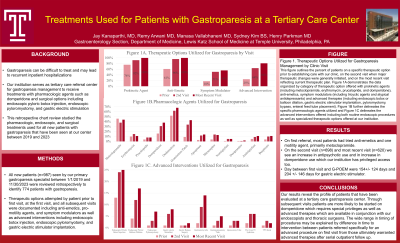Monday Poster Session
Category: Functional Bowel Disease
P2331 - Treatments Used for Patients With Gastroparesis at a Tertiary Care Center
Monday, October 28, 2024
10:30 AM - 4:00 PM ET
Location: Exhibit Hall E

Has Audio

Jay Kanaparthi, MD
Lewis Katz School of Medicine at Temple University
Philadelphia, PA
Presenting Author(s)
Jay Kanaparthi, MD1, Manasa Vallabhaneni, MD2, Remy Arwani, MBBCh1, Sydney Kim, BS1, Henry P. Parkman, MD3
1Lewis Katz School of Medicine at Temple University, Philadelphia, PA; 2Temple University Hospital, Philadelphia, PA; 3Temple University, Strafford, PA
Introduction: Gastroparesis can be difficult to treat and may lead to recurrent hospitalizations if not adequately managed. Our institution serves as tertiary care referral center for gastroparesis management with patients referred for evaluation and treatment with options not available at their institution including pharmacologic agents such as domperidone and surgical options including endoscopic pyloric botox injection, endoscopic pyloromyotomy, and gastric electric stimulator implantation. This retrospective chart review studied the pharmacologic, endoscopic, and surgical treatments used for all new patients with gastroparesis that have been seen at our center between 2019 and 2023.
Methods: All new patients (n=987) seen by our primary gastroparesis specialist between 1/1/2019 and 11/30/2023 were reviewed retrospectively to identify 774 patients with gastroparesis. Therapeutic options attempted by patient prior to first visit, at the first visit, and all subsequent visits were documented including anti-emetics, pro-motility agents, and symptom modulators, as well as advanced therapies including endoscopic botox, pyloromyotomy, and gastric electric stimulator implantation.
Results: Of the 774 patients reviewed, the therapeutic options attempted prior to referral and initiated and continued after referral are displayed in Table 1. On first referral, most patients had tried anti-emetics and one motility agent, primarily metoclopramide. After an initial establishment of care visit, most aggressive therapeutic adjustments were often performed on second visit (Table 1). On the second (n=698) and subsequent visits (n=620) we see an increase in antipsychotic use, trial of domperidone use as well as referral for advanced procedures. Day between first visit and G-POEM were 154+/- 124 days and 204 +/- 146 days for gastric electric stimulator.
Discussion: Our results reveal the profile of patients that have been evaluated at a tertiary care gastroparesis center. Through subsequent visits patients are more likely to be started on domperidone which requires special privileges as well as advanced therapies which are available in conjunction with our proceduralists. The wide range in timing of procedures may be explained by difference in time to intervention between patient referred specifically for an advanced procedure on first visit and for those who were followed over subsequent visits and ultimately warranted advanced therapies.
Note: The table for this abstract can be viewed in the ePoster Gallery section of the ACG 2024 ePoster Site or in The American Journal of Gastroenterology's abstract supplement issue, both of which will be available starting October 27, 2024.
Disclosures:
Jay Kanaparthi, MD1, Manasa Vallabhaneni, MD2, Remy Arwani, MBBCh1, Sydney Kim, BS1, Henry P. Parkman, MD3. P2331 - Treatments Used for Patients With Gastroparesis at a Tertiary Care Center, ACG 2024 Annual Scientific Meeting Abstracts. Philadelphia, PA: American College of Gastroenterology.
1Lewis Katz School of Medicine at Temple University, Philadelphia, PA; 2Temple University Hospital, Philadelphia, PA; 3Temple University, Strafford, PA
Introduction: Gastroparesis can be difficult to treat and may lead to recurrent hospitalizations if not adequately managed. Our institution serves as tertiary care referral center for gastroparesis management with patients referred for evaluation and treatment with options not available at their institution including pharmacologic agents such as domperidone and surgical options including endoscopic pyloric botox injection, endoscopic pyloromyotomy, and gastric electric stimulator implantation. This retrospective chart review studied the pharmacologic, endoscopic, and surgical treatments used for all new patients with gastroparesis that have been seen at our center between 2019 and 2023.
Methods: All new patients (n=987) seen by our primary gastroparesis specialist between 1/1/2019 and 11/30/2023 were reviewed retrospectively to identify 774 patients with gastroparesis. Therapeutic options attempted by patient prior to first visit, at the first visit, and all subsequent visits were documented including anti-emetics, pro-motility agents, and symptom modulators, as well as advanced therapies including endoscopic botox, pyloromyotomy, and gastric electric stimulator implantation.
Results: Of the 774 patients reviewed, the therapeutic options attempted prior to referral and initiated and continued after referral are displayed in Table 1. On first referral, most patients had tried anti-emetics and one motility agent, primarily metoclopramide. After an initial establishment of care visit, most aggressive therapeutic adjustments were often performed on second visit (Table 1). On the second (n=698) and subsequent visits (n=620) we see an increase in antipsychotic use, trial of domperidone use as well as referral for advanced procedures. Day between first visit and G-POEM were 154+/- 124 days and 204 +/- 146 days for gastric electric stimulator.
Discussion: Our results reveal the profile of patients that have been evaluated at a tertiary care gastroparesis center. Through subsequent visits patients are more likely to be started on domperidone which requires special privileges as well as advanced therapies which are available in conjunction with our proceduralists. The wide range in timing of procedures may be explained by difference in time to intervention between patient referred specifically for an advanced procedure on first visit and for those who were followed over subsequent visits and ultimately warranted advanced therapies.
Note: The table for this abstract can be viewed in the ePoster Gallery section of the ACG 2024 ePoster Site or in The American Journal of Gastroenterology's abstract supplement issue, both of which will be available starting October 27, 2024.
Disclosures:
Jay Kanaparthi indicated no relevant financial relationships.
Manasa Vallabhaneni indicated no relevant financial relationships.
Remy Arwani indicated no relevant financial relationships.
Sydney Kim indicated no relevant financial relationships.
Henry Parkman: Evoke Pharma – Consultant. Medtronic Enterra – Consultant. Takeda – Consultant.
Jay Kanaparthi, MD1, Manasa Vallabhaneni, MD2, Remy Arwani, MBBCh1, Sydney Kim, BS1, Henry P. Parkman, MD3. P2331 - Treatments Used for Patients With Gastroparesis at a Tertiary Care Center, ACG 2024 Annual Scientific Meeting Abstracts. Philadelphia, PA: American College of Gastroenterology.
